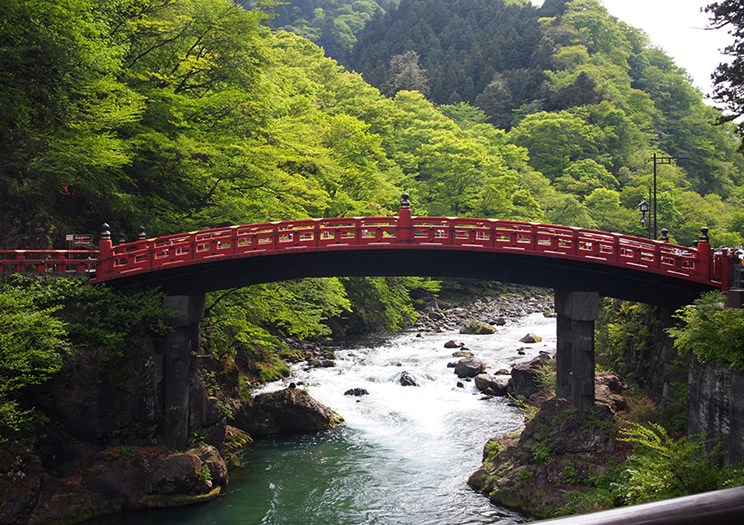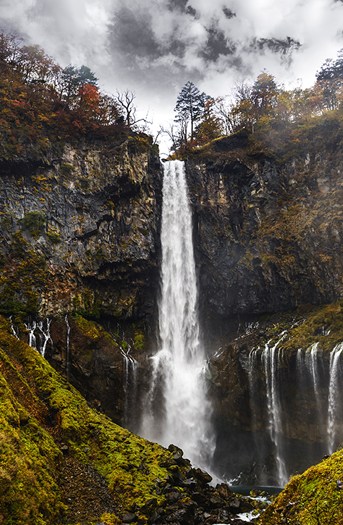Nikkō, JAPAN - About two hours north of Tokyo, nestled among the mountains of Tochigi Prefecture, sits a wealth of Japanese culture. Nikkō, which means “sunlight,” is considered one of the most beautiful places in Japan, and as I ride the Shinkansen (bullet train) through Nikkō’s countryside, I instantly understand why. The train whizzes by mountains swathed in a lush, green carpet of cedar trees, the first glance of Nikko’s unique charm.
From Tobu Nikkō station, I set off on foot to explore central Nikkō, where the area’s most iconic cultural monuments are located. The first thing to catch my eye is a vermillion bridge stretching snake-like over a slow-moving river backed by beautifully forested peaks. Shinkyo Bridge marks the entrance to Nikkō’s famous complex of UNESCO World Heritage landmarks, including one temple (Rinnō-ji) and two shrines (Futarasan and Tōshō-gū). The bridge itself belongs to Futarasan Shrine.


Above: A Garden of Eden setting is what draws people to the Nikkō area.
My first stop is Tōshō-gū — this shrine is a mausoleum for the celebrated Shogun Tokugawa Ieyasu, the founding father of the Edo Period and a highly respected figure, if the shrine’s elaborate beauty and detailed carvings are any indication.
I have plenty of time to get close and personal with the decor as the crowds make moving very slow. I’m disappointed to learn Tōshō-gū’s main feature, the lavish Yomeimon Gate, is being renovated. Just my luck. Still, the rest of the shrine is no slouch. A concert of red and gold, the buildings are painstakingly decorated with what have become national treasures.
The famous three wise monkeys (see no evil, hear no evil, speak no evil) sit above the sacred stable, and the mysterious sleeping cat, attributed to a famous carver who may not even exist, dozes over the eastern corridor. Colourful and opulent, Tōshō-gū is an oddity among Japan’s typically understated shrines.
A short walk along a peaceful cedar-lined path and I arrive at nearby Rinnō-ji Temple. This shrine was founded by Shodo Shonin, the monk who brought Buddhism to Nikkō, and houses manifestations of Nikkō’s mountains represented by three beautiful gold-leaf Buddha statues.
At the Shōyō-en Garden, I pause for a moment at the small pond surrounded by trees and shrubs. I’m told by an attendant that it’s a popular spot during kouyou — when the leaves change colour in autumn and Nikkō is at its finest — and I can easily picture the branches dipping into the still waters ablaze in red and orange leaves.
Next I take the path to the Futarasan Shrine, which is cloaked by a forest of cedar trees. As I navigate the shrine, moving with the crowds alongside mossy stone lanterns, I stumble across an unexpected sight: people playing ring toss. As I watch, a woman throws a ring at five wooden posts, but misses. I learn that this is a unique form of fortune telling. Landing just one is a sign of good luck. The woman sizes up the posts and tries again, and this time the ring flies true, looping around one of the posts and drawing cheers from those closest to her.
Though Nikkō’s UNESCO sights are impressive, the highlight of the day is the Kanmangafuchi Abyss, famous for the row of “Ghost Jizo” statues, known to add up a different number every time they’re counted. After a walk through quaint back streets and some casual greetings to locals, I end up at a wide river gurgling through a gorge. Here, a line of red-capped statues stands guard.
Perhaps because of the distance, it’s far less crowded here. I encounter perhaps 10 other people as I admire the statues (though I’m too lazy, or perhaps nervous, to count them). It’s a welcome respite after the crush of tourists at the main complex.
For lunch I decide to sample Nikkō’s local delicacy called yuba. Yuba is the skin that forms on soymilk when turning into tofu. On its own, it doesn’t have much flavour, but it’s spongy chewy texture is good for soaking up soy sauce or soup broth, and it’s a welcome addition to my warm bowl of soba noodles.
The next day I take a bus out of central Nikkō up the Irohazaka, a winding mountain road that makes my stomach clench every time I look out the window. I get off at Lake Chūzenji, named for the temple that sits near its shores.
As I step onto the grounds, I’m surprised by how few people are here, even though it’s a long weekend. Instantly, I like the energy. A bell echoes in the air and I smell smoky incense. A monk robed in blue gives a small group of us a tour and then leads us to an altar and invites us to pray.
He strikes a bowl-shaped gong, and its reverberating chime seems tangible, almost breathable. It coaxes my mind to be still and I feel, of all the temples so far, Chūzenji has brought me closest to Zen.
After another quick bus ride, I hop off at the entrance to the hiking trail through the Senjōgahara plateau. The second I step through the gate I’m surrounded by greenery and there is no one else in sight. I hike a dirt path to the soundtrack of a bubbling river on my left, occasionally passing other hikers and saying hello, until the trail turns to a wooden boardwalk and the forest gives way to scenery worthy of a Group of Seven painting.
A sea of red-brown grass bumps up against a horizon marked by mist-shrouded peaks, and the clouds look like they’ve been rendered with a celestial paintbrush. Just like that, the Senjōgahara plains cement their spot as one of the most beautiful sights I’ve seen in all my travels.
After about a two-hour hike, I exit in the Yumoto Onsen area. As I walk the road, squinting through the light of the setting sun, I can see steam rising from vents in the ground. I stop at a tiny Japanese Inn that has a hot spring so close to the source it smells like sulfur. Despite the odour, I slip into the outdoor pool. It’s twilight and the mountains are shadowy giants against a blue screen of sky. The water makes my skin tingle and I feel like I’m truly experiencing the rejuvenating powers of Japan’s hot springs.
By the time I’m boarding the Shinkansen back to Tokyo the next day, I’ve already vowed to visit Nikkō again.
About the Author
Amanda Taylor is a freelance writer who has lived in Tokyo and travelled all over Asia. She's written for Japan's top magazines, Time Out Tokyo and Metropolis. Her travel choices are suspiciously linked to how spicy a country's food happens to be: the hotter the better. From trekking through ancient ruins to sunbathing on private beaches, she's down for anything that involves a plane ticket and a passport.